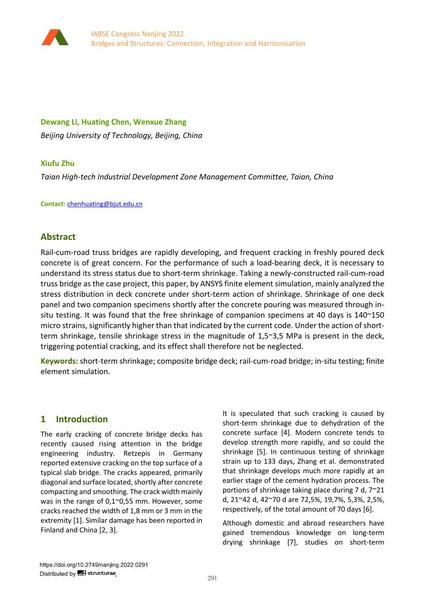Effect of Short-Term Shrinkage on Deck Concrete of a Rail-Cum-Road Composite Truss Bridge

|
|
|||||||||||
Bibliografische Angaben
| Autor(en): |
Dewang Li
(Beijing University of Technology, Beijing, China)
Huating Chen (Beijing University of Technology, Beijing, China) Wenxue Zhang (Beijing University of Technology, Beijing, China) Xiufu Zhu (Taian High-tech Industrial Development Zone Management Committee, Taian, China) |
||||
|---|---|---|---|---|---|
| Medium: | Tagungsbeitrag | ||||
| Sprache(n): | Englisch | ||||
| Tagung: | IABSE Congress: Bridges and Structures: Connection, Integration and Harmonisation, Nanjing, People's Republic of China, 21-23 September 2022 | ||||
| Veröffentlicht in: | IABSE Congress Nanjing 2022 | ||||
|
|||||
| Seite(n): | 291-300 | ||||
| Anzahl der Seiten (im PDF): | 10 | ||||
| DOI: | 10.2749/nanjing.2022.0291 | ||||
| Abstrakt: |
Rail-cum-road truss bridges are rapidly developing, and frequent cracking in freshly poured deck concrete is of great concern. For the performance of such a load-bearing deck, it is necessary to understand its stress status due to short-term shrinkage. Taking a newly-constructed rail-cum-road truss bridge as the case project, this paper, by ANSYS finite element simulation, mainly analyzed the stress distribution in deck concrete under short-term action of shrinkage. Shrinkage of one deck panel and two companion specimens shortly after the concrete pouring was measured through in- situ testing. It was found that the free shrinkage of companion specimens at 40 days is 140~150 micro strains, significantly higher than that indicated by the current code. Under the action of short- term shrinkage, tensile shrinkage stress in the magnitude of 1,5~3,5 MPa is present in the deck, triggering potential cracking, and its effect shall therefore not be neglected. |
||||
| Stichwörter: |
Verbundfahrbahnplatte Finite-Elemente-Simulation
|
||||
| Copyright: | © 2022 International Association for Bridge and Structural Engineering (IABSE) | ||||
| Lizenz: | Die Urheberrechte (Copyright) für dieses Werk sind rechtlich geschützt. Es darf nicht ohne die Zustimmung des Autors/der Autorin oder Rechteinhabers/-in weiter benutzt werden. |
||||
